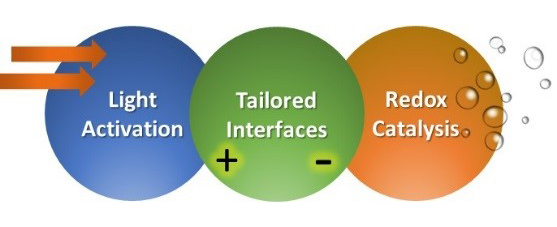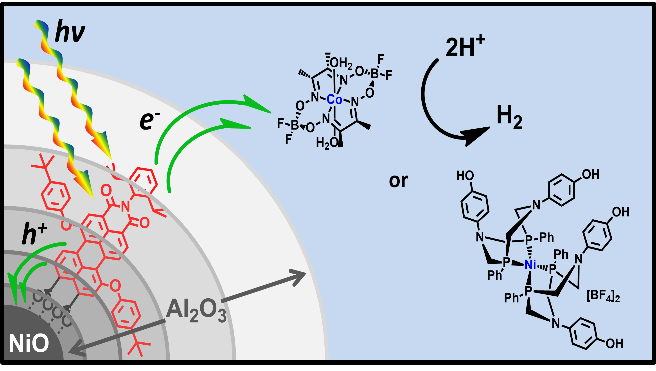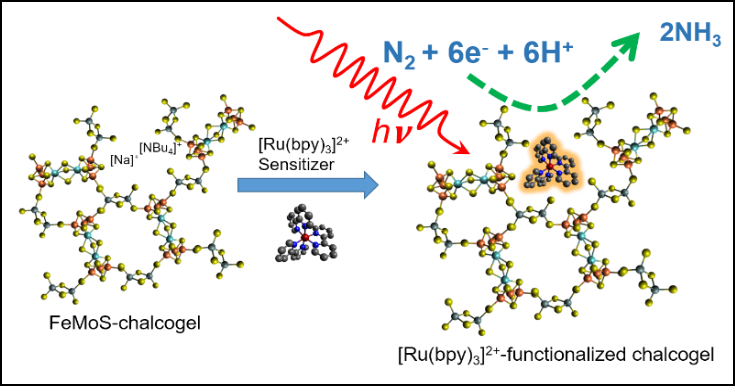LEAP Research Areas
LEAP research during the next two years is organized into three interwoven thrusts with closely integrated approaches and team synergies, which will target the following new directions and goals to support the LEAP mission:
 |
| Figure 1. Synergistic LEAP Research Thrusts |
- Research Thrust 1: Powering Redox Processes will produce charges at potentials required to drive energy-demanding redox reactions with temporal and spatial precision using unconventional organic/inorganic semiconductors.
- Research Thrust 2: Tailored Interfaces and Hierarchical Assemblies will tailor interfaces between Thrust 1 semiconductors and Thrust 3 redox catalysts using hierarchical assemblies to control charge flow to power the catalysts.
- Research Thrust 3: Redox Catalysts for Energy-Demanding Reactions will design, synthesize, and characterize molecules and materials with catalytic metal centers that will utilize charges provided by Thrust 1 semiconductors to perform energy-intensive reactions, such as H2O splitting, CO2 and N2 reduction, and C-C bond formation.
Research Thrust 1: Powering Redox Processes
The goal of LEAP Thrust 1 is to leverage emerging classes of unconventional semiconductors to create charges at potentials sufficient to drive the catalysts described in Thrust 3 to carry out energy-demanding redox processes.
Achieving this goal will involve four types of closely related materials: Organic semiconductors (OSs), perovskite semiconductors (PSs), quantum dots (QDs), and 2D dichalcogenides. These new semiconductors have recently astounded the energy conversion community with their long excited-state lifetimes, excellent charge mobilities, large photocurrents, broad optical absorption, chemical versatility, and the advancing stability.
These new semiconductors have enabled major advances in fundamental understanding, resulting in greater extraction of photon energy with open-circuit voltages well above 1 V and fill factors near 80 percent. The understanding-based approaches described here aim to achieve potential differences between extracted charges of up to 1.5-2.0 V to drive catalytic chemical reactions.
Thrust 1 will pursue research in these two areas (See Figure 2 below):
- Organic Semiconductors
- Hybrid Perovskite Semiconductors

Research Thrust 2: Tailored Interfaces and Hierarchical Assemblies
The goal of LEAP Thrust 2 is to understand the interplay between materials and molecular chemistry to temporally and spatially control the flow of photogenerated charges to productive redox catalytic centers, while stabilizing all system components under conditions that are far from thermodynamic and chemical equilibrium.
In the most elegant natural light-activated redox processes, e.g., photosynthesis by Photosystem II, energy and charge are guided by a precise potential energy landscape enabled by covalent and non-covalent bonding and hierarchical design. In multicomponent synthetic systems, interfaces between components are inevitably accompanied by structural, chemical, and electronic defects such as non-lattice-matched structures, under-coordinated atoms, adventitious adsorbates, and connections having low electronic coupling.
Interrogating and tailoring interfaces in order to (i) minimize defects that degrade thermodynamic potential, and (ii) exploit or engineer defects that lower barriers for desired reactions—for instance, by inducing vectorial charge transfer or localizing multiple redox equivalents near a catalytic site—is critical for enabling multi-electron redox reactions.
Thrust 2 will pursue research in these two areas:
- Chemistry of Functional Interfaces (e.g. Figure 3 below)
- Hierarchical Photocatalytic Mesostructures

Research Thrust 3: Redox Catalysts for Energy-Demanding Reactions
The goal of LEAP Thrust 3 is to design catalysts for efficient electron-driven chemical transformations—catalysts that can be interfaced/integrated (Thrust 2) with unconventional semiconductors (Thrust 1). Achieving this goal will involve understanding how light-powered molecular and heterogeneous catalysts accomplish electron-driven, chemoselective transformations involving important, but challenging molecular substrates such as CO2 and N2.
We will investigate chemical transformations that entail charge transfer, including proton-coupled electron transfer, and that can be driven with visible light. Of great interest are reactions that convert photonic energy into stored chemical energy, and that involve C-C, C-O, O-O, C-H, N-N, N-O, and N-H bond making and breaking.
Thrust 3 will pursue research in these six areas:
- Heterogenized Molecular Catalysts and Electrocatalysts that Controllably and Efficiently Activate N-N, C-O, C-H, N-H or O-H Bonds
- Electrode-Supported, ALD-Synthesized, Few-Atom Catalytic Clusters
- CO2 Reduction and C-C Bond Formation via Atomically Precise, MOF-Supported, Electrode-Integrated, Catalytic Clusters
- MOF-Templated Metal(0) and Alloy-Like Metal(0) Nanoparticles as CO2 Reduction and C-C Bond Forming Catalysts
- Metal Nitrides as Scaling-Relationship-Disrupting Electrocatalysts for N2 Reduction
- Understanding Reductive Catalysis by Chalcogels (e.g. Figure 4 below)



